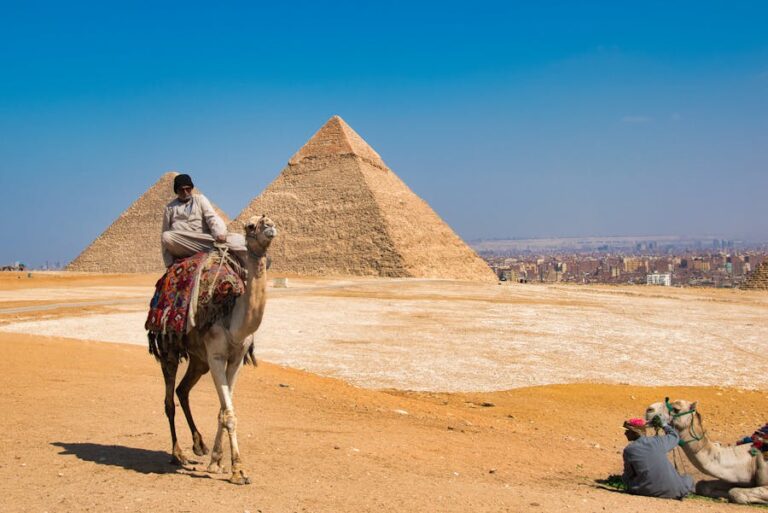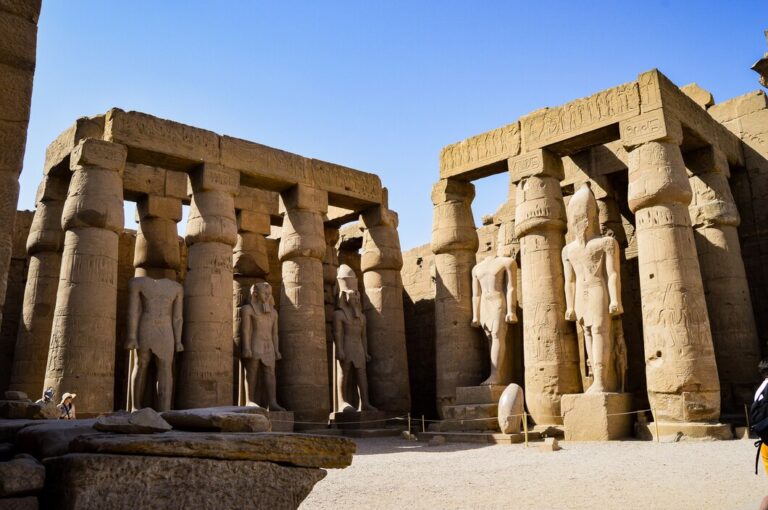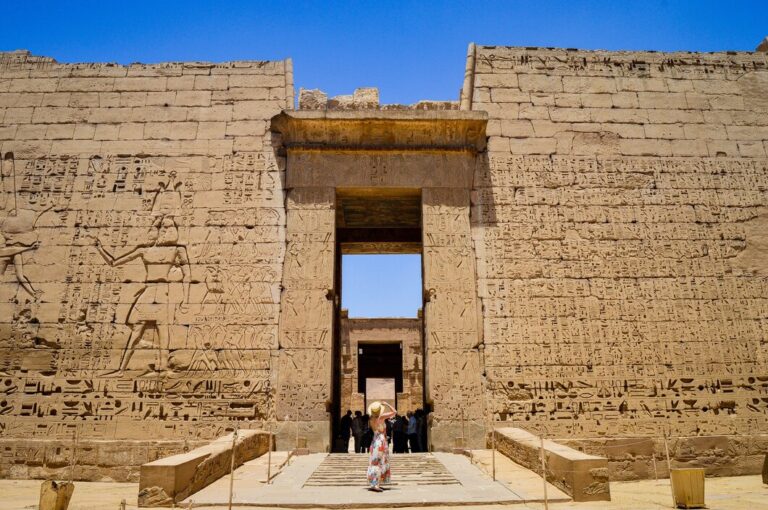30 Ancient Egypt Pictures That Will Make You Want To Travel
Ancient Egypt, with its monumental achievements and enigmatic artifacts, continues to captivate the imagination of travelers and historians alike. From towering pyramids and grand temples to intricate sculptures and vibrant tomb paintings, the remnants of this ancient civilization offer a rich tapestry of history and culture. These 30 pictures capture the essence of Egypt’s majestic past and are sure to inspire a journey through one of the most fascinating and storied civilizations in human history.
1. The Pyramids of Giza
The Pyramids of Giza, particularly the Great Pyramid of Giza, are timeless symbols of ancient Egypt. The Great Pyramid, originally built as a tomb for Pharaoh Khufu, was the tallest man-made structure in the world for over 3,800 years. The precise construction and alignment with the cardinal points of the compass reflect the advanced understanding of astronomy and engineering possessed by the ancient Egyptians. The pyramids’ massive scale and enduring mystery continue to draw awe and admiration from visitors worldwide.
2. The Sphinx of Giza
The Great Sphinx, with its lion’s body and human head, is a guardian of the Giza Plateau and a profound symbol of strength and wisdom. Carved from a single piece of limestone, the Sphinx measures about 240 feet long and 66 feet high. It is believed to represent Pharaoh Khafre, serving as both a protective deity and a reflection of his divine power. The Sphinx’s weathered features and its role in the ancient city’s spiritual landscape make it a compelling subject of study and admiration.
3. Temple of Karnak
The Temple of Karnak, one of the largest religious complexes ever constructed, is a sprawling testament to the grandeur of ancient Egyptian architecture. The temple is dedicated to the god Amun and features a forest of towering columns in the Hypostyle Hall, intricately decorated with hieroglyphs and carvings. The sheer scale of Karnak, with its massive pylons and obelisks, reflects the wealth and power of Thebes during the New Kingdom period, providing an awe-inspiring glimpse into ancient Egyptian religious life.
4. Temple of Luxor
The Temple of Luxor, located in the heart of modern Luxor, was once the center of the city’s religious activities. Its grand entrance, flanked by colossal statues of Ramses II, leads to a series of beautifully decorated courtyards and halls. The temple’s architectural design and its alignment with the annual Opet Festival highlight its significance in the worship of the Theban triad of Amun, Mut, and Khonsu. The temple is particularly striking at sunset when its columns and statues are bathed in a warm, golden light.
5. Valley of the Kings
The Valley of the Kings, situated on the west bank of the Nile, is the final resting place of many of Egypt’s New Kingdom pharaohs. The tombs, carved into the cliffs, are renowned for their elaborate and colorful wall paintings depicting the journey to the afterlife. Notable tombs include those of Tutankhamun and Ramses VI. The Valley’s intricate burial rituals and the treasures found within these tombs offer a fascinating glimpse into ancient Egyptian beliefs and practices surrounding death and the afterlife.
6. Temple of Hatshepsut
The Temple of Hatshepsut, designed by the queen herself, is an architectural marvel set against the cliffs of Deir el-Bahari. Its terraced design and colonnaded terraces blend harmoniously with the surrounding landscape. The temple is notable for its detailed reliefs and inscriptions that celebrate Hatshepsut’s reign and divine birth. It stands as a testament to her unique position as a female pharaoh and her contributions to Egyptian architecture and culture.
7. Abu Simbel Temples
The Abu Simbel Temples, carved into a mountainside by Ramses II, are iconic for their colossal statues and grand scale. The main temple features four monumental statues of Ramses II seated on thrones, each over 60 feet tall. These temples were relocated in the 1960s to save them from the rising waters of Lake Nasser, demonstrating the incredible effort to preserve ancient heritage. The temples’ alignment with the sun, which illuminates the inner sanctum on specific dates, reflects the advanced astronomical knowledge of the ancient Egyptians.
8. Temple of Philae
The Temple of Philae, dedicated to the goddess Isis, was originally located on Philae Island but was relocated to Agilkia Island following the construction of the Aswan High Dam. The temple is renowned for its well-preserved reliefs and its picturesque setting on the Nile. The intricate carvings and the temple’s serene environment highlight its importance as a center of worship and pilgrimage during the Ptolemaic period.
9. Medinet Habu
Medinet Habu, built by Ramses III, is a fortress-like temple complex known for its detailed reliefs depicting the pharaoh’s military victories and religious rituals. The imposing walls and monumental pylons reflect the temple’s role in showcasing Ramses III’s power and divine favor. The well-preserved carvings and inscriptions provide valuable insights into the political and religious life of the period.
10. Temple of Edfu
The Temple of Edfu, dedicated to the falcon god Horus, is one of the best-preserved temples from ancient Egypt. Its large, well-decorated entrance pylon and the hypostyle hall with its towering columns offer a glimpse into the grandeur of Ptolemaic religious architecture. The temple’s detailed reliefs depict mythological scenes and rituals, showcasing the importance of Horus in Egyptian religion.
11. Temple of Kom Ombo
The Temple of Kom Ombo is unique for its dual design, dedicated to both the crocodile god Sobek and the falcon god Horus. The symmetrical layout of the temple reflects the dual nature of the deities worshipped there. The temple’s reliefs and inscriptions provide insights into the religious practices and the role of these gods in ancient Egyptian society.
12. The Step Pyramid of Djoser
The Step Pyramid of Djoser, designed by the architect Imhotep, represents a significant architectural evolution from the traditional mastaba tombs. As the earliest pyramid, it features a series of stacked platforms, creating a stepped appearance. The pyramid and its surrounding complex, known as the Saqqara necropolis, illustrate the early experimentation with pyramid construction techniques.
13. The Rosetta Stone
The Rosetta Stone, discovered in 1799, is a crucial artifact in deciphering Egyptian hieroglyphs. The stone bears inscriptions in three scripts—hieroglyphic, demotic, and Greek—which allowed scholars to eventually unlock the secrets of ancient Egyptian writing. Its significance lies in bridging the gap between ancient and modern understanding of Egyptian language and culture.
14. The Bust of Nefertiti
The Bust of Nefertiti, discovered in 1912, is one of the most iconic and exquisite examples of ancient Egyptian art. The limestone sculpture, featuring the beautiful queen’s elegant profile, reflects the high level of craftsmanship and the importance of Nefertiti as a prominent queen during the Amarna Period.
15. The Colossi of Memnon
The Colossi of Memnon, two massive statues of Amenhotep III, stand in solitary grandeur near the site of his mortuary temple. The statues, each approximately 60 feet tall, were originally erected to guard the entrance to the temple. Their imposing presence and the inscriptions on their bases provide insights into the architectural and artistic achievements of Amenhotep III’s reign.
16. The Temple of Dendur
The Temple of Dendur, now housed in the Metropolitan Museum of Art, was originally located in Nubia and dedicated to the gods Isis and Osiris. Its relocation to the museum offers visitors a chance to admire its beautifully preserved carvings and to experience a piece of Egyptian heritage within a modern setting.
17. The Catacombs of Kom el Shoqafa
The Catacombs of Kom el Shoqafa in Alexandria represent a fascinating blend of Egyptian, Greek, and Roman art and architecture. The underground burial chambers feature elaborate frescoes, sculptures, and inscriptions that reflect the cultural syncretism of Alexandria during the Roman period.
18. The Temples of Abydos
The Temples of Abydos, particularly the Temple of Seti I, are known for their elaborate reliefs and inscriptions depicting the ancient Egyptian pantheon. The site is significant for its religious importance and its role in the rituals and ceremonies associated with the worship of Osiris, the god of the afterlife.
19. The Chapel of Hathor
The Chapel of Hathor at Dendera is renowned for its vibrant and well-preserved astronomical and mythological reliefs. The ceiling, depicting the sky goddess Hathor, features detailed representations of constellations and celestial events, offering insights into ancient Egyptian cosmology and religious beliefs.
20. The Pyramid of Snefru
The Pyramid of Snefru, including both the Bent Pyramid and the Red Pyramid, represents the evolution of pyramid construction techniques. The Bent Pyramid, with its unique angled sides, reflects the transition from stepped to smooth-sided pyramids, while the Red Pyramid exemplifies the final form of true pyramid design.
21. The Temple of Amada
The Temple of Amada, one of the oldest in Nubia, is notable for its well-preserved reliefs and inscriptions. Built during the reign of Thutmose III, the temple features detailed depictions of the king’s military campaigns and religious offerings to the gods.
22. The Temple of Kalabsha
The Temple of Kalabsha, dedicated to the Nubian god Mandulis, is renowned for its intricate carvings and well-preserved structures. Its relocation from its original site to Lake Nasser reflects the importance of preserving Nubian heritage amid modern development.
23. The Temple of Qasr Ibrim
The Temple of Qasr Ibrim showcases a unique combination of Egyptian and Roman architectural elements. Located in Nubia, the temple reflects the cultural interactions and influences that shaped the region during the Roman period.
24. The Temple of Taffeh
The Temple of Taffeh, dedicated to the goddess Sekhmet, features impressive reliefs and inscriptions depicting the goddess’s protective and healing attributes. The temple’s artistic details highlight the significance of Sekhmet in Egyptian religion and mythology.
25. The Temple of Dakka
The Temple of Dakka, constructed during the reign of Ptolemy II, is notable for its well-preserved carvings and inscriptions. Dedicated to the god Thoth, the temple’s architecture and decorations provide insights into the religious and cultural life of the Ptolemaic period.
26. The Temple of Esna
The Temple of Esna, dedicated to the god Khnum, is renowned for its beautifully preserved hypostyle hall. The temple’s detailed reliefs and columns offer a glimpse into the religious practices and artistic achievements of the Roman and late periods.
27. The Temple of Hibis
The Temple of Hibis, located in Kharga Oasis, features impressive inscriptions and carvings that reflect the religious and cultural influences of the later periods of ancient Egypt. The temple’s architecture and decorations provide valuable insights into the region’s history and significance.
28. The Temple of Seti I at Abydos
The Temple of Seti I at Abydos is famous for its detailed wall reliefs, including the famous List of Kings, which records the names of past pharaohs. The temple’s extensive decorations and inscriptions provide valuable historical and religious context.
29. The Temple of Hatshepsut at Deir el-Bahari
The Temple of Hatshepsut at Deir el-Bahari is an architectural masterpiece, with its grand terraces and colonnades blending seamlessly into the surrounding cliffs. The temple’s design and decorations celebrate Hatshepsut’s reign and her divine connection.
30. The Temple of Karnak at Night
The Temple of Karnak at night offers a dramatic and enchanting view of ancient Egyptian architecture. The illuminated columns and obelisks create a captivating atmosphere, highlighting the temple’s grandeur and the intricate details of its design.







